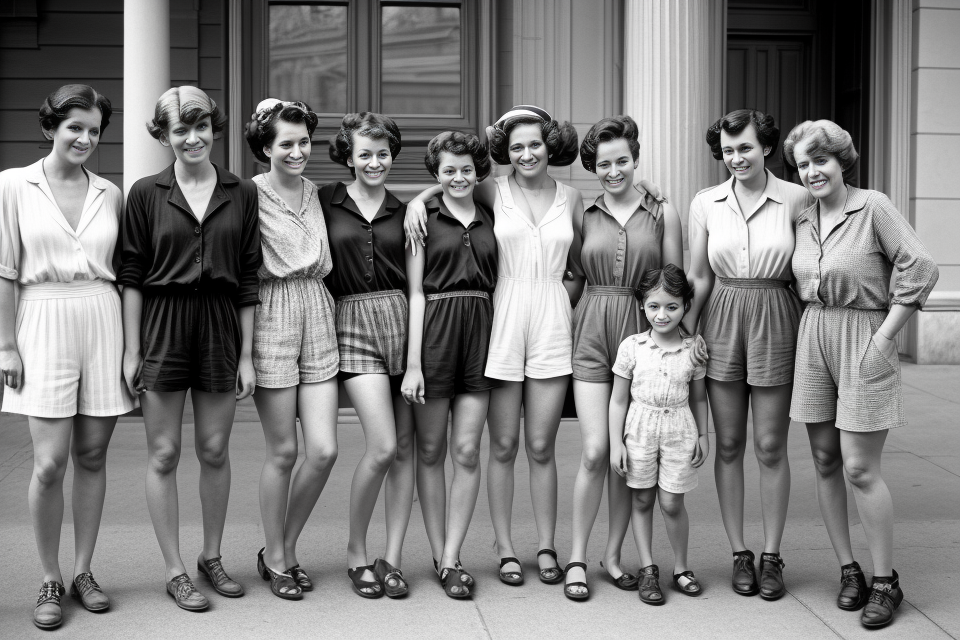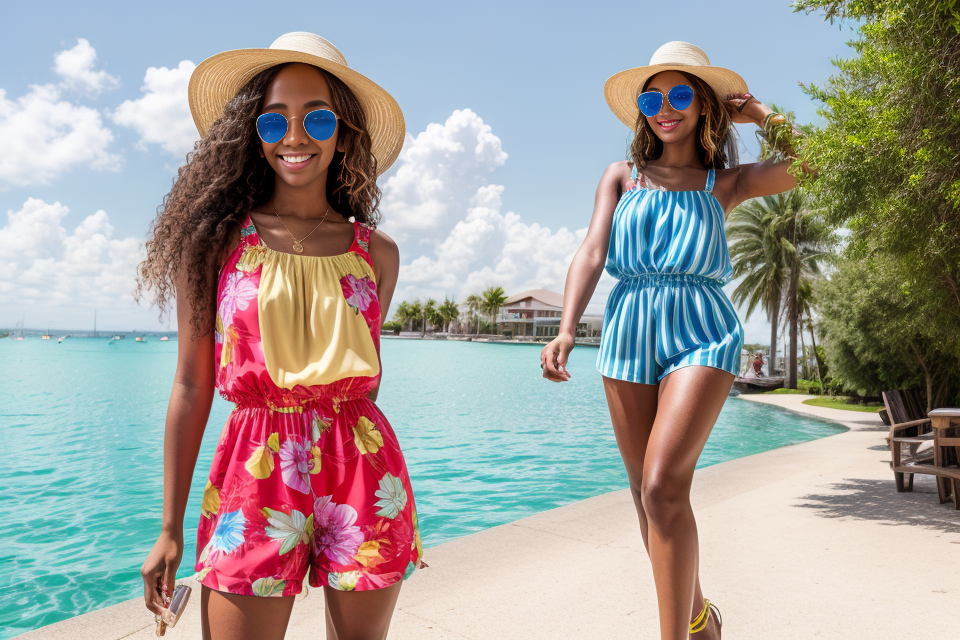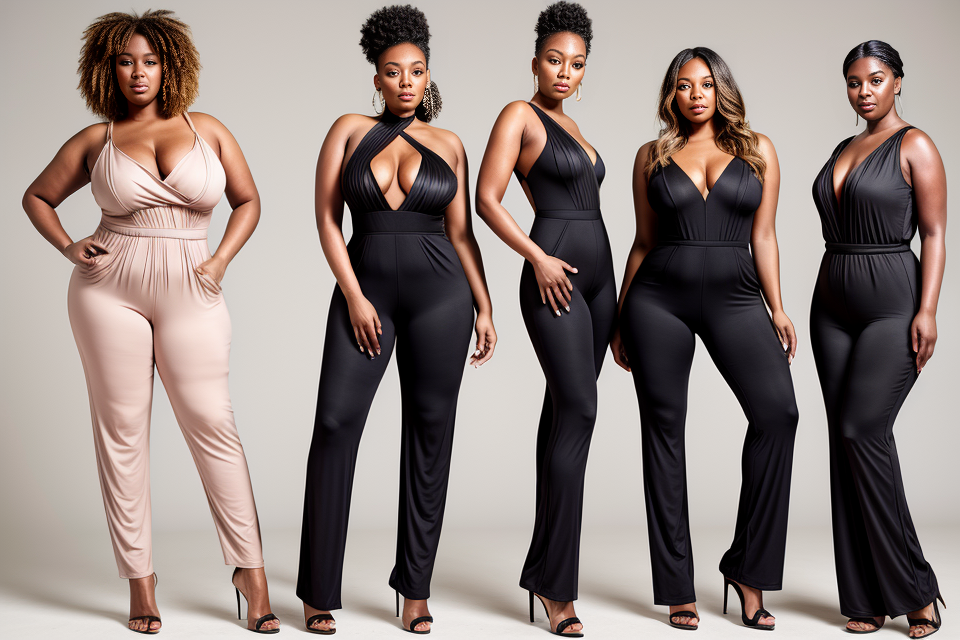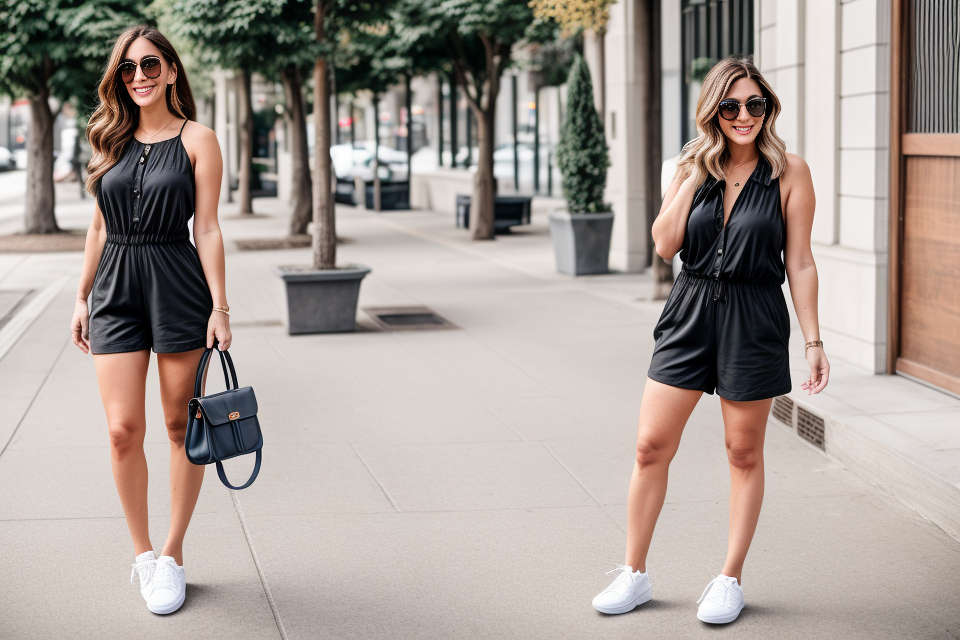When did rompers become a thing? This is a question that has puzzled many people for years. The romper, also known as a jumpsuit or overalls, is a type of clothing that has been around for centuries, but it wasn’t until the early 20th century that it became a popular fashion item. In this article, we will take a closer look at the history of the romper and how it has evolved over time. From its origins as a practical garment for workers to its transformation into a fashionable piece of clothing, the romper has come a long way. So, let’s dive in and explore the fascinating history of this versatile piece of clothing.
Rompers, also known as onesies or jumpsuits, have been around for many years and have evolved significantly over time. The earliest versions of rompers were worn by infants and were essentially just a one-piece garment with short sleeves and legs. Over the years, rompers have become more popular for adults as well, and have evolved to include a variety of styles and designs. Today, rompers can be found in a range of materials, including cotton, denim, and silk, and can be worn for a variety of occasions, from casual outings to formal events. Despite their evolution, rompers continue to be a popular and practical choice for those looking for a comfortable and easy-to-wear outfit.
The Origins of Rompers
The Evolution of Infant Clothing
The evolution of infant clothing can be traced back to ancient civilizations, where parents sought to protect their children from the elements and provide them with modesty. In early societies, infants were often swaddled in long, rectangular pieces of cloth, which were tied at the waist or around the shoulders to keep the child warm and secure. As civilizations progressed, so did the methods of clothing infants.
During the Middle Ages, the romper-like garment known as the “gown” became popular for young children. The gown was a loose, tunic-like garment that extended to the knees or ankles and was often fastened with buttons or laces. The gown was worn by both boys and girls and was a practical, one-piece outfit that was easy to put on and take off.
In the 19th century, the industrial revolution led to the mass production of clothing, including infant garments. The romper began to take shape as a separate garment for infants, often with a button-front and short sleeves. The romper was seen as a more practical alternative to the traditional dress for young children, as it allowed for easier movement and independence.
As the 20th century approached, the romper continued to evolve. In the 1920s, the “onesie” was introduced, which was a one-piece garment with long sleeves and a bottom that extended to the feet. The onesie was popular for its convenience and ease of use, and it remained a staple in infant clothing for decades to come.
Today, the romper continues to be a popular choice for infants and toddlers, with modern variations that include snap closures, adjustable straps, and a range of colors and patterns. The romper’s enduring popularity can be attributed to its simplicity, practicality, and ability to accommodate the active lifestyle of young children.
The Emergence of Rompers in the Early 20th Century
In the early 20th century, rompers made their debut as a practical and stylish option for infants and young children. The garment’s origins can be traced back to the early 1900s, when the concept of a one-piece outfit for toddlers began to gain popularity.
One of the earliest recorded instances of rompers was in 1912, when a designer named F.L. Sharp introduced a new style of infant clothing called the “Jump Suit.” This garment was designed to be a more practical alternative to traditional separate pieces of clothing for babies, such as diapers, shirts, and pants. The Jump Suit quickly gained popularity among parents who appreciated the convenience and ease of use it provided.
Another significant development in the history of rompers occurred in the 1920s, when fashion designers began to experiment with new styles and materials. In particular, the use of lightweight and breathable fabrics like cotton and linen allowed for the creation of rompers that were both comfortable and fashionable. The introduction of these new materials helped to further establish rompers as a popular choice for infants and young children.
By the 1930s, rompers had become a mainstay of children’s fashion, with many parents opting for this convenient and stylish option for their little ones. The garment’s popularity continued to grow throughout the mid-century period, with new designs and styles emerging in response to changing cultural and social norms.
Overall, the emergence of rompers in the early 20th century marked a significant shift in the way that infants and young children were dressed. By offering a practical and stylish alternative to traditional separate pieces of clothing, rompers helped to redefine the boundaries of children’s fashion and establish themselves as a popular choice for parents and children alike.
Rompers Go Mainstream
The Popularity of Rompers in the 1950s and 1960s
In the post-World War II era, rompers experienced a surge in popularity among both children and adults. The 1950s and 1960s were a time of significant social and cultural change, and the romper became a symbol of this new era.
One reason for the romper’s popularity during this time was the emergence of a more casual, relaxed style of dress. With the rise of the teenage culture and the decline of formal dress codes, people began to embrace more comfortable and practical clothing options. Rompers offered a convenient and stylish alternative to traditional garments like dresses and trousers, and their versatility made them a popular choice for both playtime and everyday wear.
The 1950s and 1960s also saw the rise of a new, youth-driven fashion culture. Magazines like Seventeen and Vogue began to feature fashion trends and advice for young people, and teenagers began to experiment with their clothing choices in ways that had never been seen before. Rompers became a staple of this new fashion culture, with young people wearing them to school, on dates, and even to formal events.
The romper’s popularity during this time was also fueled by the growth of the mass media and the spread of popular culture. With the advent of television and the rise of popular music, young people were exposed to new styles and trends on a daily basis. The romper, with its bright colors and playful design, became a symbol of this new, youth-driven culture.
Overall, the 1950s and 1960s were a pivotal time in the history of the romper. With their combination of comfort, style, and practicality, rompers became a popular choice for people of all ages, and their association with the new, youth-driven fashion culture cemented their place in the history of modern dress.
The Rise of Designer Rompers in the 1980s and 1990s
During the 1980s and 1990s, rompers experienced a significant rise in popularity, particularly among the fashion-conscious. Designers began to take notice of the romper’s potential as a versatile garment that could be dressed up or down, and they started incorporating the style into their collections.
One of the most influential designers to embrace the romper was Ralph Lauren. In the 1980s, Lauren began to feature rompers in his Polo line, using high-quality materials and classic colors to appeal to a wider audience. Lauren’s rompers were often made from luxurious fabrics like silk and cashmere, and featured intricate details like plaid patterns and contrasting cuffs.
Another designer who helped to popularize the romper was Gianni Versace. In the 1990s, Versace began to incorporate rompers into his iconic collections, often using bold colors and striking prints to create a bold, sexy look. Versace’s rompers were often made from lightweight, breathable fabrics like chiffon and georgette, and featured cutouts and other daring design elements.
The rise of designer rompers in the 1980s and 1990s was not just limited to high-end fashion. Mass-market retailers also began to offer rompers as part of their collections, making the style more accessible to a wider range of consumers. Brands like J.Crew and Gap started to feature rompers in their catalogs and stores, offering a more casual, everyday version of the garment.
Overall, the rise of designer rompers in the 1980s and 1990s helped to solidify the romper’s place in mainstream fashion. The style was no longer just a practical garment for infants and toddlers, but a versatile and fashionable choice for adults of all ages. The influence of designers like Ralph Lauren and Gianni Versace helped to elevate the romper to new heights of popularity, making it a staple of the modern wardrobe.
The Resurgence of Rompers
The Fashion Revival of Rompers in the 2000s
In the early 2000s, rompers made a comeback in the fashion world, popularized by celebrities and fashion icons. The revival of rompers was seen as a departure from the conservative fashion trends of the 1990s, and was seen as a playful and youthful addition to the wardrobes of both men and women.
One of the key factors in the resurgence of rompers was the rise of streetwear and athleisure wear. The romper’s practicality and comfort made it a popular choice for those looking for casual, yet stylish clothing. Additionally, the romper’s versatility made it a popular choice for layering under jackets or wearing as a standalone garment.
The fashion industry also played a role in the revival of rompers, with designers such as John Galliano and Alexander McQueen showcasing rompers in their runway shows. This exposure helped to further popularize the garment and make it a staple in the wardrobes of fashion-conscious individuals.
Overall, the resurgence of rompers in the 2000s was a reflection of the changing fashion landscape and the desire for more playful and youthful clothing options.
The Current State of Romper Fashion
The romper has experienced a resurgence in recent years, with fashion designers and retailers alike embracing the one-piece garment as a versatile and stylish option for both casual and formal occasions. Today’s rompers come in a wide range of styles, fabrics, and colors, catering to a diverse range of tastes and preferences.
Some of the key trends in contemporary romper fashion include:
- Sustainable and Eco-Friendly Rompers: Many fashion brands are now offering rompers made from sustainable and eco-friendly materials, such as organic cotton, bamboo, and recycled polyester. These rompers are often designed with a focus on comfort, durability, and timeless style.
- Statement Rompers: In addition to classic and minimalist designs, rompers with bold and attention-grabbing details are also popular. These may include unique patterns, colors, or cuts that make a statement and add visual interest to the outfit.
- Gender-Neutral Rompers: The traditional gendered approach to fashion has given way to a more inclusive and fluid approach, with many designers offering gender-neutral rompers that can be worn by anyone, regardless of gender identity or expression.
- Casual and Athleisure Rompers: For everyday wear, rompers in comfortable and practical fabrics such as cotton and denim are popular, as are rompers designed for active wear, such as those made from moisture-wicking and stretchy materials.
- Formal and Cocktail Rompers: For more formal occasions, rompers are also available in luxurious fabrics such as silk, velvet, and lace, and may feature intricate details such as embroidery, beading, or sequins. These rompers are often designed to be dressier and more formal than their casual counterparts.
Overall, the current state of romper fashion is characterized by a diverse range of styles and options, catering to a wide range of tastes and preferences. Whether you’re looking for a comfortable and casual option for everyday wear or a statement piece for a formal occasion, there’s a romper out there for everyone.
Cultural Significance of Rompers
The Romper as a Symbol of Youth and Playfulness
The romper has become a staple of children’s clothing, but it wasn’t always seen as a fashionable garment. In fact, the romper has a rich history that is tied to cultural and social changes throughout the years.
One of the reasons why the romper became popular is because it represents a symbol of youth and playfulness. The romper’s design, which consists of a one-piece jumpsuit, allows for easy movement and play, making it a perfect choice for young children.
The romper’s association with youth and playfulness can be traced back to the early 20th century when it was first introduced as a garment for infants and toddlers. The romper’s design, which includes short sleeves and short legs, was intended to make it easy for young children to move around and play without any hindrances.
The romper’s association with youth and playfulness was further reinforced during the 1950s and 1960s, when the romper became a popular choice for summer wear. During this time, the romper was often made from lightweight materials such as cotton and was worn by children who were playing outside during the warmer months.
The romper’s association with youth and playfulness has continued to be a defining characteristic of the garment throughout the years. Today, the romper is still a popular choice for young children, and it continues to represent a symbol of youth and playfulness.
However, it’s important to note that the romper’s association with youth and playfulness has also been used to reinforce gender stereotypes. For example, rompers have often been marketed towards girls, with the assumption that they are more suitable for playful and carefree children. This has led to the romper being seen as a feminine garment, and has limited its popularity among boys and men.
Despite these gender stereotypes, the romper remains a popular choice for young children, and its association with youth and playfulness continues to be a defining characteristic of the garment.
The Impact of Rompers on Gender and Sexuality
Rompers have had a significant impact on gender and sexuality, challenging traditional norms and expectations. Here are some ways in which rompers have influenced these aspects of society:
- Blurring gender lines: Rompers have been worn by both men and women, challenging the traditional gender binary. This has helped to promote a more inclusive and diverse view of gender expression.
- Redefining femininity: The wearing of rompers by women has been seen as a way to reclaim and redefine femininity, moving away from the notion that women should only wear dresses or skirts. This has helped to expand the definition of femininity and give women more options for expressing themselves.
- Promoting comfort and practicality: Rompers have been embraced for their comfort and practicality, allowing people to move freely and comfortably without having to worry about layers or restrictions. This has been particularly important for parents who want to dress their children in comfortable and practical clothing.
- Challenging traditional notions of sexuality: The wearing of rompers by both men and women has also challenged traditional notions of sexuality, promoting a more fluid and inclusive view of sexual identity. This has helped to create a more accepting and supportive environment for people of all sexual orientations.
Overall, the impact of rompers on gender and sexuality has been significant, helping to challenge and change traditional norms and expectations. By promoting inclusivity, diversity, comfort, and practicality, rompers have played a role in creating a more accepting and supportive society.
The Future of Rompers
The Continued Evolution of Romper Fashion
The romper has come a long way since its inception, and its evolution continues to this day. As fashion trends come and go, the romper has managed to maintain its relevance and appeal to modern consumers.
The Impact of Sustainable Fashion
One of the key factors driving the continued evolution of romper fashion is the growing importance of sustainability in the fashion industry. Consumers are becoming increasingly conscious of the environmental impact of their clothing choices, and many are turning to sustainable and eco-friendly options.
In response to this trend, designers are experimenting with new materials and production techniques to create rompers that are more environmentally friendly. For example, some designers are using organic cotton and recycled materials to create rompers that are both stylish and sustainable.
The Rise of Athleisure
Another factor driving the evolution of romper fashion is the rise of athleisure. Comfort and functionality have become increasingly important to consumers, and many are looking for clothing that can be worn for both athletic activities and everyday wear.
As a result, designers are creating rompers that are both fashionable and functional. These rompers often feature moisture-wicking materials and flexible designs that allow for a full range of motion.
The Influence of Streetwear
Finally, the influence of streetwear on romper fashion cannot be ignored. Streetwear has become a dominant force in the fashion industry, and many designers are incorporating elements of this style into their romper designs.
This has led to the creation of rompers with bold graphics, oversized silhouettes, and statement accessories. These rompers are often worn as a statement piece, and are popular among young and trend-conscious consumers.
Overall, the continued evolution of romper fashion is driven by a variety of factors, including sustainability, athleisure, and streetwear. As the fashion industry continues to evolve, it will be interesting to see how the romper adapts and changes alongside it.
The Role of Sustainability in Romper Design
In recent years, there has been a growing emphasis on sustainability in fashion, and rompers are no exception. Designers are increasingly incorporating eco-friendly materials and production methods into their romper designs, in response to consumer demand for more sustainable clothing options.
One way that designers are making rompers more sustainable is by using organic cotton or other natural fibers, which are produced using methods that are less harmful to the environment. Organic cotton, for example, is grown without the use of synthetic pesticides or fertilizers, which can contaminate waterways and harm wildlife.
Another approach is to use recycled materials in romper production. This can include recycled polyester, which is made from plastic bottles, or reclaimed cotton, which is salvaged from fabric scraps and old clothing. By using recycled materials, designers can reduce their reliance on new resources and minimize waste.
In addition to using eco-friendly materials, designers are also exploring new production methods that are more sustainable. For example, some are using digital printing techniques that require less water and energy than traditional screen printing. Others are using zero-waste patterns that minimize fabric waste and reduce the amount of material needed to produce a romper.
Overall, the trend towards sustainability in romper design is driven by a growing awareness of the environmental impact of the fashion industry, as well as consumer demand for more eco-friendly clothing options. As consumers become more conscious of the environmental footprint of their clothing choices, designers will continue to innovate and develop new sustainable romper designs that meet their needs and preferences.
The Impact of Rompers on Parenting and Childcare
The Convenience of Rompers for Busy Parents
Rompers have been a staple in childrenswear for decades, but their convenience for busy parents has only become more apparent in recent years. The romper’s design, which combines the top and bottom into one garment, has made it a popular choice for parents who are short on time and looking for easy, practical clothing options for their children.
One of the key advantages of rompers for busy parents is their ease of use. Because rompers are designed to be worn as a complete outfit, they eliminate the need to separate the top and bottom pieces when dressing a child. This can save parents valuable time in the morning, especially when getting multiple children ready for the day.
In addition to their convenience, rompers are also a practical choice for parents who are on-the-go. The garment’s design allows for easy movement, making it ideal for children who are always on the move. This is especially useful for parents who have young children who are constantly crawling or walking, as rompers provide a comfortable and practical option that allows children to move freely without the hassle of constantly having to adjust their clothing.
Furthermore, rompers are often made from lightweight, breathable fabrics that are comfortable for children to wear, even in warm weather. This makes them a popular choice for parents who want to dress their children in comfortable, practical clothing that can be worn in a variety of settings.
Overall, the convenience of rompers for busy parents is a significant factor in their enduring popularity. With their ease of use, practicality, and comfort, rompers continue to be a popular choice for parents who want to dress their children in comfortable, practical clothing that is easy to use and wear.
The Debate Around the Use of Rompers for Older Children and Adults
As rompers became increasingly popular for infants and toddlers, there emerged a debate around their use for older children and even adults. Some argued that rompers were a practical and comfortable option for those who wanted to avoid the hassle of dressing and undressing, while others criticized the garment for being infantilizing and impractical for those outside of early childhood.
One of the main concerns about the use of rompers for older children and adults was the potential for them to be perceived as babyish or immature. Critics argued that rompers were associated with a lack of autonomy and independence, and that they reinforced stereotypes about gender roles and expectations.
Additionally, rompers were often seen as impractical for older children and adults who needed to engage in activities that required more movement and flexibility. The lack of separate legs and the restricted range of motion could make it difficult for older individuals to engage in certain activities, such as running or biking.
Despite these concerns, some proponents of rompers for older children and adults argued that the garment was a comfortable and practical option for those who wanted to avoid the hassle of dressing and undressing. They also pointed out that rompers could be a fun and playful option for those who wanted to express their individuality and creativity.
Overall, the debate around the use of rompers for older children and adults highlighted the complex and often conflicting attitudes towards clothing and identity. While some saw rompers as a practical and comfortable option, others viewed them as infantilizing and impractical. Ultimately, the decision to wear rompers or not was left up to individual preference and circumstance.
FAQs
1. What is a romper?
A romper is a one-piece garment that consists of a top and bottom part, typically worn by infants and young children. It is designed to be a convenient and practical outfit for little ones who are still learning to dress themselves.
2. When did rompers first become popular?
Rompers have been around for over a century, but they first became popular in the 1920s. They were initially worn by young children and were often made of lightweight, breathable fabrics like cotton or linen.
3. How has the design of rompers changed over time?
The design of rompers has evolved significantly over the years. In the early days, rompers were relatively simple, with a straight-legged design and a short torso. Today, rompers come in a variety of styles, including those with elastic waists, adjustable straps, and even zip-up closures.
4. What factors have contributed to the popularity of rompers?
The popularity of rompers can be attributed to several factors, including their convenience, versatility, and comfort. They are easy to put on and take off, making them ideal for busy parents who want to dress their children quickly and easily. Additionally, rompers can be worn for a variety of occasions, from casual outings to formal events.
5. Are rompers still popular today?
Yes, rompers are still popular today, especially among parents who appreciate their convenience and versatility. They are often worn as a stylish and comfortable alternative to traditional onesies or overalls. With a wide range of styles and colors available, rompers continue to be a popular choice for young children’s clothing.



